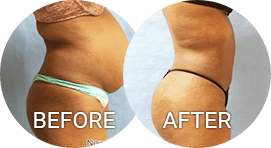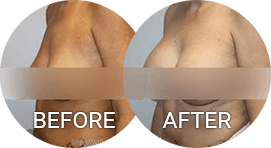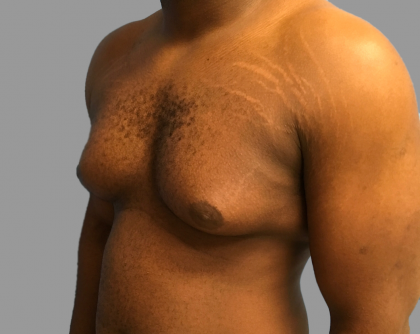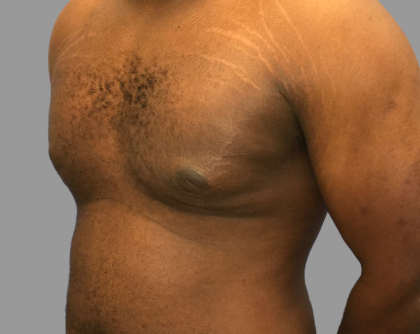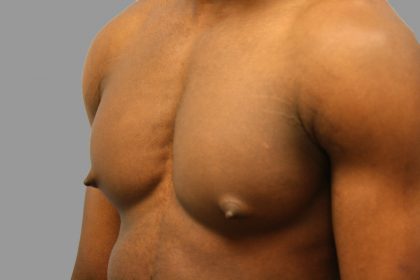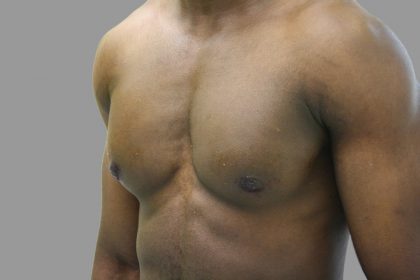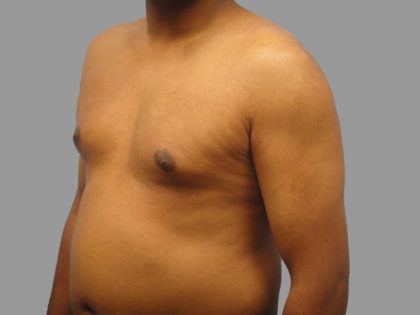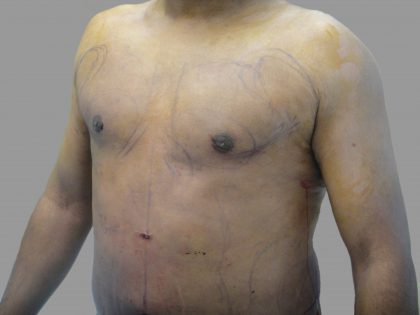Gynecomastia
Consultations offered at our two convenient locations in Manhattan and Long Island, NY

Gynecomastia, a condition characterized by the noncancerous growth of glandular tissue in male breasts, typically arises from factors such as heightened estrogen levels, reduced testosterone activity, or the consumption of certain medications. Male breast reduction surgery can effectively eliminate excess breast tissue and sculpt the chest into a more defined and masculine shape, allowing men to regain confidence in their bodies. According to the American Board of Cosmetic Surgery, approximately 50 percent of men over 44 experience gynecomastia at some point in their lives, resulting in what is commonly referred to as “man boobs.” [1] This condition can cause feelings of embarrassment and hinder comfort in one’s own skin and clothing.
Dr. Gordon Andan of New York Surgical Arts has built a reputation for procedures that change the course of his patients’ lives. He knows how important feeling good in your own skin is and after an assessment, he knows how to help each patient regain their love of self and life. If you’re tired of seeing unwanted chest fat every time you look in the mirror, it may be time to consider male breast reduction surgery in New York City or Garden City, NY. Below, our comprehensive guide will assist you in planning your gynecomastia treatment, from the initial consultation to the outstanding outcomes. Call (516) 746-0155 or reach out online to get started.
The NYSA blog has all of the information patients need to learn about procedures they may be considering. Check it out.
Contents
- 1 Before & After Photos
- 2 Before and After Photos
- 3 What is Gynecomastia?
- 4 What are the Benefits of Gynecomastia?
- 5 Your Male Breast Reduction Consultation
- 6 How to Prepare for Gynecomastia
- 7 The Procedure
- 8 Recovering from Male Breast Reduction
- 9 Life after Male Breast Reduction
- 10 Corresponding & Complementary Procedures
- 11 Cost of Male Breast Reduction in Manhattan
- 12 References
Before & After Photos
Before and After Photos
What is Gynecomastia?
Given the prevalence of “man boobs,” it’s not surprising that 18,575 male breast reduction surgeries were performed in the US in 2020 alone. [2] While many men strive for a well-toned chest, hitting the gym alone often falls short. Despite efforts in exercise and diet, various factors can lead to the accumulation of fat or flab in the chest area.
Asymptomatic gynecomastia is highly prevalent and commonly occurs in three distinct age groups:
- Neonates
- Adolescents going through puberty
- Older males
Gynecomastia can be attributed to a variety of factors, one of which is a hormonal imbalance between testosterone and estrogen. Testosterone, commonly known as the male hormone, is responsible for promoting masculine characteristics, including muscle development and a deep voice. On the other hand, estrogen, typically associated with female physiology, regulates the growth and development of breast tissue. A hormonal imbalance disrupts the normal hormonal equilibrium and can lead to the development of excess breast tissue, causing the characteristic swelling or enlargement of the breasts in men.
Gynecomastia is unrelated to an individual’s body mass index (BMI), contrary to popular belief. While excess weight and obesity can contribute to an increase in overall body fat, resulting in larger breasts, true gynecomastia involves the growth of glandular tissue specifically in the male breasts. This kind of excess tissue in the male chest can solely be addressed through surgical excision of the surplus glandular tissue. It is important that men understand that the development of enlarged male breasts can occur irrespective of their commitment to a dedicated workout routine.
In addition to hormonal imbalances, the use of certain medications can also contribute to the development of gynecomastia. Various drugs have been associated with the onset or exacerbation of this condition. [3] Steroid use among male bodybuilders also increases the risk of developing gynecomastia because they disrupt the natural hormone balance in the body. [4] Dr. Andan will discuss your medical history when determining the probable cause of your excess breast tissue.
What is Pseudo-Gynecomastia?
Unlike true gynecomastia, pseudo-gynecomastia is characterized by an accumulation of excess fat in the breast area, rather than an overgrowth of glandular tissue. Still, for individuals with pseudo-gynecomastia, weight loss may not always resolve the issue because the excess fat in the breast area can be stubborn and resistant to traditional weight loss efforts. Even with a dedicated exercise regimen and a healthy diet, specifically targeting the reduction of fat in the breast region can prove challenging.
Do I Have Gynecomastia?
The question has likely crossed the minds of most men at some point in their lives. It’s not surprising that men who prioritize fitness and have a muscular physique may sometimes feel that their chest protrudes in a way that they find unappealing. If you engage in bodybuilding or rigorous workouts yet your chest appears slightly saggy or lacks muscle definition, it could be attributed to the presence of gynecomastia rather than a lack of muscular development.
Having a prominent chest as a man doesn’t necessarily have to be seen as a negative thing, as opinions on whether you have “man boobs” can vary depending on individual perspectives.
If you have experienced struggles with weight management, it’s possible that the expansion of fat cells has led to the development of flabby breasts. During puberty, many boys notice temporary swelling in their breasts, which typically resolves on its own within a matter of months or sometimes years. As men age, a higher proportion of testosterone is converted into estrogen, increasing their vulnerability to gynecomastia. [5]
Ultimately, the most crucial consideration is how you personally feel about your chest. If you’re uncertain about whether male breast reduction is the right option for you, it may be helpful to reflect on the following questions:
- Does your breast tissue feel uncomfortable and move noticeably when you run?
- Do your nipples chafe during workouts or during day-to-day activities?
- Do your nipples or the surrounding tissue regularly feel sore?
- Do your nipples appear erect and puffy?
- Does your breast skin or tissue sag?
- Do you dread occasions where you might need to remove your shirt, like beach days or pool outings?
- Are attempts at firming up your chest with diet and exercise unsuccessful?
If you answered yes to any of the above questions, it may be time to start thinking about a consultation with Dr. Andan. Call (516) 746-0155 to schedule yours today!
What are the Benefits of Gynecomastia?
Gynecomastia treatment offers several benefits that can significantly improve the quality of life for individuals with this condition. Here are some of the key advantages:
- Enhanced physical appearance
- Increased self-confidence
- Improved comfort and functionality
- Clothing freedom
- Increased ease and comfort when shirtless
- Psychological well-being
Your Male Breast Reduction Consultation

The pre-surgery consultation with Dr. Andan is an opportune moment to address any queries or concerns you may have regarding male breast reduction. His primary responsibility is to ensure that you are well informed about the procedure, at ease with your decision to proceed, and knowledgeable about the available options. While Dr. Andan will guide you through the process, you can prepare yourself. Here are some tips to help you make the most of your New York Surgical Arts consultation:
- Communicate the reasons behind your visit. Clearly express what aspects of your body you are dissatisfied with and the specific changes you hope to achieve. Providing specific details will help Dr. Andan understand your goals and tailor the treatment plan accordingly.
- Ask Dr. Andan about his recommended approach based on the needs and preferences you have expressed. While you may have already conducted extensive independent research, his experience and expertise can provide valuable insights that you may not have considered.
- Take the opportunity to discuss important aspects of the procedure with Dr. Andan, such as the placement of incisions, the expected duration of the procedure, the type of anesthesia (general or local) that will be administered, and any other relevant specifics concerning your male breast reduction appointment.
How to Prepare for Gynecomastia
As the day of your appointment approaches, it’s natural to experience some apprehension. To help maintain a sense of calm and relaxation, consider the following tips:
- Don’t take blood thinners or drink alcohol in the days leading up to your procedure
- Make an effort to quit smoking at least six weeks before your surgery
- Arrange for a friend or family member to accompany you to your appointment
- Stock your freezer with ice packs or bags of frozen vegetables. These can be invaluable for reducing swelling during the initial days of healing.
- Create a comfortable recovery area in your home where you can relax during the healing process. Fill the space with your favorite books, and entertainment, and ensure easy access to drinking water and a nearby bathroom.
By following these suggestions, you can help alleviate anxiety and prepare yourself for a smoother recovery. Remember to consult with your surgeon for personalized instructions and recommendations tailored to your specific circumstances.
Reaching Your Target Weight Before Surgery
While not everyone with gynecomastia or pseudo-gynecomastia intends to lose weight, it is advisable to assess your body’s weight status as you plan for surgery and ensure that you are at a healthy and stable weight.
Many male breast reduction procedures involve the use of liposuction to eliminate excess fat cells in and around the breasts. Therefore, it is important to reach your ideal weight well in advance of your surgery. Furthermore, it is generally recommended that patients who have undergone weight loss and seek cosmetic surgery maintain their target weight for a minimum of 6 months before the procedure. This timeframe allows for weight stabilization and demonstrates the commitment to adopting long-term healthy habits.
The Procedure
Male breast reduction surgery is personalized to suit your physique and desired aesthetic outcomes. While each technique is tailored to the individual, there are two commonly utilized approaches to male breast reduction.
Pseudo-Gynecomastia Liposculpture
Targeted liposuction may be sufficient for pseudo-gynecomastia. During this procedure, small incisions will be strategically made on and around the breasts. A specialized instrument called a cannula will be inserted through these incisions to gently break up and remove the excess fat cells. If necessary, Dr. Andan may also address any loose skin or surplus tissue before closing the incisions. Additionally, the nipples may be resized or repositioned as deemed appropriate by Dr. Andan.
Surgery for Gynecomastia
For men with genuine gynecomastia resulting from a hormonal imbalance, surgical excision of the glandular tissue is typically necessary to achieve the desired outcome. During this procedure, incisions are usually made around the areola or concealed within the natural chest creases. Through these incisions, Dr. Andan will meticulously remove the excess glandular tissue and skin. In some cases, liposculpture may be performed concurrently to provide a more comprehensive approach to sculpting the male chest. If needed, the nipples can be resized or repositioned during the procedure to enhance the overall aesthetic result.
Recovering from Male Breast Reduction
After your procedure, it’s important to prioritize your recovery period for optimal healing and results. Here are some guidelines to ensure a smooth recovery:
- Take time off from work and your regular activities. Rest is crucial, so give yourself a few days to relax and recover at home.
- Get enough sleep to support your body’s healing process. Sufficient sleep aids in muscular recovery, hormone balance, and overall mental well-being.
- Stay hydrated. Proper hydration promotes healthy blood circulation and reduces the risk of complications.
- Avoid engaging in strenuous activities for at least one month following the surgery.
Adhere to the New York Surgical Arts post-operative instructions, which may include wearing a compression garment to improve blood circulation, using cold compresses, or avoiding certain medications. Follow these instructions carefully and consult Dr. Andan if you have any uncertainties.
Life after Male Breast Reduction
As your results continue to evolve and improve over the next six months, you’ll notice a more defined and sculpted appearance to your chest, enhancing your body’s masculine contour.
The healing process of scars typically takes place within the first year following surgery, although continued fading can occur beyond that timeframe. Maintaining an active lifestyle and avoiding substances that affect hormone levels, such as steroids, is recommended to minimize the likelihood of requiring additional procedures.
Male breast reduction has been a life-changing procedure for countless men, empowering them to feel more confident, comfortable, and masculine in their own skin. By addressing the physical and psychological discomforts associated with a flabby or enlarged chest, you can leave those concerns behind and embark on a fresh chapter of self-assurance and improved body image.
Corresponding & Complementary Procedures
For certain individuals, undergoing cosmetic surgery is a significant decision, and it may be advantageous to combine a breast reduction procedure with additional treatments to minimize the overall recovery time.
- Liposculpture is a specialized liposuction technique that uses meticulous manual manipulation to enhance muscle definition. By sculpting specific areas such as the abdominal muscles, upper arm muscles, or torso, liposculpture can accentuate a more masculine physique.
- Nipple reduction is often incorporated into male breast reduction surgeries. Reducing the size of the nipples not only enhances the visual appearance of the male chest but also improves physical comfort.
- A well-defined jawline can enhance the facial features of many men who perceive their face and neck as appearing too soft or round. Liposuction procedures targeting the double chin area can effectively minimize the appearance of excess fat, resulting in a more youthful and fit look. In addition, chin implants can provide men with a sense of enhanced definition and facial balance.
Cost of Male Breast Reduction in Manhattan
Dr. Andan will discuss the cost of your procedure(s) during the consultation appointment. Call (516) 746-0155 to schedule your appointment in New York or Garden City, NY.
References
- FRANK Q. NUTTALL, Gynecomastia as a Physical Finding in Normal Men, The Journal of Clinical Endocrinology & Metabolism, Volume 48, Issue 2, 1 February 1979, Pages 338–340, https://doi.org/10.1210/jcem-48-2-338
- American Society of Plastic Surgeons. PLASTIC SURGERY STATISTICS REPORT 2020.; 2020. https://www.plasticsurgery.org/documents/News/Statistics/2020/plastic-surgery-statistics-full-report-2020.pdf
- Nuttall FQ, Warrier RS, Gannon MC. Gynecomastia and drugs: a critical evaluation of the literature. European Journal of Clinical Pharmacology. 2015;71(5):569-578. https://doi.org/10.1007/s00228-015-1835-x
- Hoffman JR, Ratamess NA. Medical issues associated with anabolic steroid use: are they exaggerated? Journal of sports science & medicine. 2006;5(2):182-193. https://www.ncbi.nlm.nih.gov/pmc/articles/PMC3827559/
- Johnson RE, Murad MH. Gynecomastia: Pathophysiology, Evaluation, and Management. Mayo Clinic Proceedings. 2009;84(11):1010-1015. https://www.ncbi.nlm.nih.gov/pmc/articles/PMC2770912/




